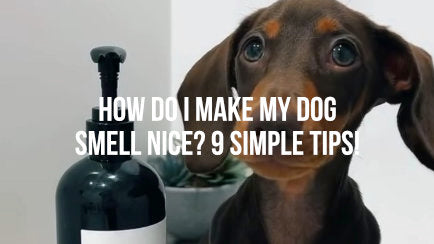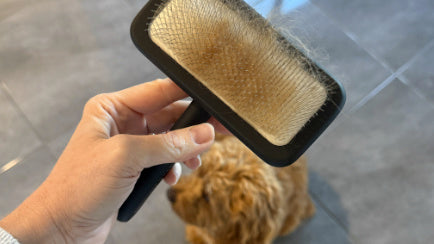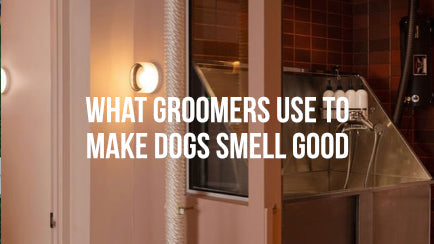Do I Need a Slicker Brush? Understanding the Order of Grooming Tools
So… Do You Really Need a Slicker Brush?
If your idea of grooming is giving your dog a quick once-over with whatever brush you found at the back of the laundry cupboard... we realllly need to talk.
The truth is, if you want your dog to have a coat that’s silky, shiny, and free from tangles (and that will keep you in the groomers good books), you’re going to want two MVPs in your toolkit: the dog slicker brush and the dog grooming comb.
And yes, the order you use them in matters. Think of it like your own haircare routine. You wouldn’t skip conditioner after shampoo, right? Same rules apply here.
Meet the Slicker Brush. Your Tangle Terminator.
A slicker brush for dog grooming is basically a magic wand for fluffy, curly, or high-maintenance coats.
The fine, angled pins glide through fur like a dream, loosening knots, removing loose hair, and leaving that fresh-from-the-salon volume we all love.
Perfect for:
-
Curly coats (i.e. Cavoodles, Poodles, Bichons)
-
Long coats (i.e. Shih Tzus, Afghan Hounds, Maltese)
-
Double coats (i.e. Golden Retrievers, Aussies, Border Collies, Pomeranians)
Our Soft Pin Slicker Brush is the luxe version. Gentle enough for sensitive skin, tough enough on tangles, and chic enough to leave out on your coffee table.
Meet the Comb. Your Detail-Oriented Bestie.
The dog grooming comb (aka the finisher) is your precision tool. Once the slicker has done the heavy lifting, the comb steps in to smooth, separate, and style.
If you’re fluffing faces, perfecting partings, or ensuring no sneaky knots are hiding, this is your go-to.
The Comb de Luxe has dual-spaced teeth:
-
Wide teeth - tackle tangles, dense fur, and undercoats (hello, dematting dog comb duties).
-
Fine teeth - for smoothing, detailing, and that “show dog” finish.
Bonus: the curved design makes fluffing around the face ridiculously easy (and leaves them looking adorable).
The Order of Operations. Brush First, Comb Second.
If you remember one thing, make it this: Slicker first, comb second.
-
Slicker Brush: Work in the direction of coat growth with gentle strokes to remove loose hair, dirt, and tangles.
-
Comb: Glide through with the wide teeth first, then switch to fine teeth for detail work. If it snags, go back to the slicker.
Why this order works: it’s faster, gentler, and leaves the coat smoother than doing it the other way around.
Why You’ll Want Both in Your Grooming Game
-
Tangle-free bliss - no more matting drama.
-
Healthier skin & coat - stimulates circulation, distributes natural oils.
-
Better bonding - grooming time = quality time.
-
That final polish - the comb gives the kind of finish you want people to notice.
How to Choose the Right Slicker Brush & Comb
-
Gentle pins or rounded teeth to protect skin.
-
Lightweight design for long grooming sessions without the arm ache.
-
Ergonomic handles for better control.
-
Premium materials - because they last (and look good doing it).
If you’re serious about your dog’s coat looking its best, you need both tools and you need to use them in the right order. The slicker brush preps and detangles, the comb smooths and perfects.
Because every good outfit starts with great hair... and your dog deserves that main-character energy too.
If you still have questions keep scrolling down to our list of FAQ's below!
Ready to shop the tools?
Shop Grooming Tools and Bundles
FAQ: Your Slicker Brush & Comb Questions Answered
Q: How often should I use a slicker brush on my dog?
A: 2–3 times a week is great for most dogs. Daily for curly, long, or high-shed coats. (AKA my cheeky Cavoodle that always has knots - but she loves it!)
Q: Can I use a slicker brush on all dogs?
A: Yes. Especially if it’s a soft pin slicker brush for dog grooming. Just go really gently on short fine coats.
Q: Which comes first, slicker brush or comb?
A: Always the slicker first, then the comb for the perfect finish.
Q: What’s the difference between a dog grooming comb and a slicker brush?
A: Slicker = detangle, demat, fluff, remove loose hair. Comb = smooth, style, detail.
Q: Will a comb help with an undercoat?
A: Yes. A dog comb for undercoat with wide teeth can gently loosen and remove dense fur.




